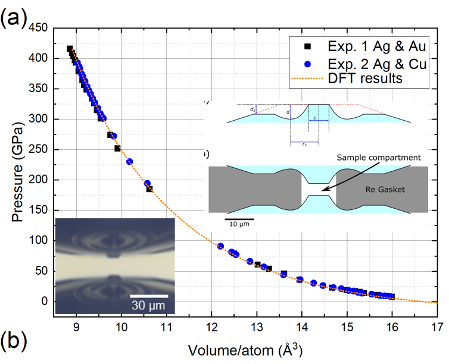Enduring nobility and stability in silver at extreme pressure
Silver, a noble metal, is renowned for its purity and chemical stability at standard temperature and pressure. However, theoretical calculations and shock-physics experiments at pressures in excess of 100 GPa (1 million times greater than standard atmospheric pressure) suggest that silver’s ambient-pressure phase become unstable. A collaborative team of experimentalists and theorists from LLNL’s Condensed Matter Physics Section within the Physics Division and High Pressure Collaborative Access Team (HPCAT) at the Advanced Photon Source have revealed that the face-centered-cubic phase of silver is, in fact, stable at room temperature up to at least 420 GPa, a pressure three times greater than previous results. This new work implies a complicated high-pressure/high-temperature phase diagram to be consistent with recent shock experiments.
To measure the structure of silver to these extreme pressures, the team used toroidal diamond anvil cells (t-DAC) developed by LLNL's high pressure group, combined with advanced multichannel collimators at HPCAT beamline 16 of APS synchrotron source to collect high signal-to-noise X-ray diffraction patterns. The small sample size and extreme pressures precluded hydrostatic conditions, so the team used analytical tools which included calculated elastic constants to correct for non-hydrostatic conditions and evaluate the equation of state. The calculated elastic constants revealed softening in the C44 elastic modulus, suggestive of a structural instability that yields to a body-centered-cubic ground state for pressures near or above 1 TPa.
[O’Bannon, E.F., Lipp, M.J., Smith, J.S., Meng, Y., P. Soderlind, Young, D., and Jenei, Zs. (2021) The ultrahigh pressure stability of silver: An experimental and theoretical study. Journal of Applied Physics, 129, 125901. https://doi.org/10.1063/5.0045374]


